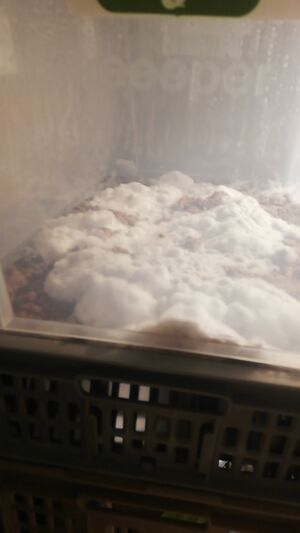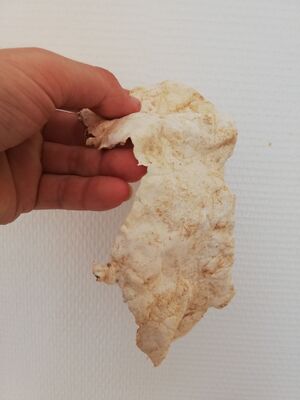Mycelium Leather
The dutch company Ecovative grows Reishi mycelium into the air, separates it from the substrate and compresses it to make leather. I try to recreate this procedure.
Literature
Growth environment
To prevent fruiting, CO2 concentration is kept at 5-7% and the temperature at +-30° C. A mister maintains the humidity above 99%. The hyphae grow up to escape CO2 and get oxygen.
Airflow increases homogeneity by delivering humidity and/or minerals, by eliminating micro climates or by mechanical force.
Minerals in the mist increase growth speed by osmotic pressure.
A humid substrate means faster growth but lower density.
Growth substrates
From the patent "Increased homogeneity of mycological biopolymer grown into void space":
| Corn stover | 600 g |
| Poppy seeds | 144 g |
| Maltodextrin | 25 g |
| Calcium sulfate | 8 g |
| Water | 1600 g |
| Spawn | 288 g |
Procedure
After compression, the mycelium is left for 3 days to strengthen, then dried at 43° C followed by heat pressing if desired.
My own experiments
First test in a monotub
First I made grain spawn out of bird seeds. Then I sterilized a box with rubbing alcohol, lined the bottom with a clean plastic film and spread sterilized substrate made of 0.75l hardwood pellets, 0.2l wheat bran and 0.75l water onto the film. I distributed some grain spawn on top of it, closed the box and waited.
The mycelium colonized the surface and grew about 1.5 cm thick as in the pictures. After four days I sprayed water on it to keep it humid, but the droplets crushed the fluffy mycelium and it stopped growing.
I let it dry and peeled it off the substrate. It was fused with the chunks of grain spawn, so I didn't get one big tissue but many small pieces, the biggest one shown in the picture. Depending on how much it was crushed it feels like paper (but more fragile) or like a very soft, light and flexible tissue. It is very thin and rips apart easily.
What to improve
The grain spawn should be broken into smaller pieces using disposable gloves, and evenly mixed with the substrate. Using unpopped popcorn as grains may be a good idea since it doesn't stick together as much as bird seeds.
Experimenting with substrates in petri dishes
On the 2.5.2023 I filled petri dishes with Agar, malt extract, maizena, yeast extract and gypsum according to the following table.
| Ingredient | Substrate | Malt | Maizena | Yeast | Gypsum | 8 days |
|---|---|---|---|---|---|---|
| 1 | Agar | very bad | ||||
| 2 | Agar | 0.5 g | good | |||
| 3 | Agar | 0.05 g | very bad | |||
| 4 | Agar | 0.5 g | 0.05 g | bad | ||
| 5 | Agar | 0.5 g | 0.05 g | 0.025g | bad | |
| 6 | Agar | 0.5 g | very bad | |||
| 7 | Agar | 0.5 g | 0.05 g | very bad | ||
| 8 | Agar | 0.5 g | 0.025g | bad | ||
| 9 | ||||||
| 10 | Pellets & Bran | good | ||||
| 11 | Pellets & Bran | 0.5 g | very good | |||
| 12 | Pellets & Bran | 0.05 g | very good | |||
| 13 | Pellets & Bran | 0.025g | very good |
To accurately measure those values I dissolved the nutrients in water solutions and used a pipetter. However gypsum is not soluble so the quantities may be inaccurate, and Maizena clumped together, so I put clumps of it into the petri dishes.
Heated inoculation chamber
It would be nice to have a chamber that can heat sterilize itself and the substrate, and then keep the temperature constant at 25 or 30° C. I am buying the XH-W1209 thermostat: https://www.berrybase.ch/xh-w1209-digitales-thermostat/temperaturschalter-12v-frei-programmierbar
A very cheap CO2 meter
Since an electronic CO2 sensor costs 60 CHF I make an analog one. Henry's law states that the amount of a dissolved gas in water is proportional to the partial pressure in the air above the water. Furthermore, dissolved CO2 lowers the ph of water. This means that by filling a small bowl with distilled water and measuring its pH we can guess the CO2 concentration of the air. Since the math are complicated, we just assume a linear (or exponential) relation and calibrate with the known atmospheric concentration and gas mixtures with CO2 made from baking soda and vinegar.
[CO2] = a(T) + b(T)*pH
<references \>


